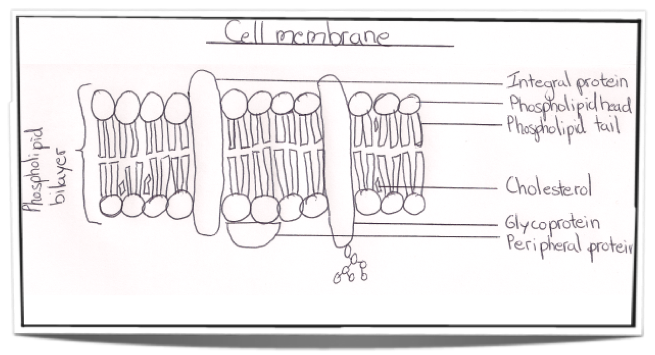Membranes
2.4.1 Draw and label a diagram to show the structure of membranes.

Figure 2.4.1 - Annotated drawing of a cell membrane
2.4.2 Explain how the hydrophobic and hydrophilic properties of phospholipids help to maintain the structure of cell membranes.
Phospholipid molecules make up the cell membrane and are hydrophilic (attracted to water) as well as hydrophobic (not attracted to water but are attracted to other hydrophobic tails). They have a hydrophilic phosphate head and two hydrophobic hydrocarbon tails. Cell membranes are made up of a double layer of these phospholipid molecules. This is because in water the hydrophilic heads will face the water while the hydrophobic tails will be in the center because they face away from the water. The phospholipid bilayer makes the membrane very stable but also allows flexibility. The phospholipid in the membrane are in a fluid state which allows the cell to change it’s shape easily.
2.4.3 List the functions of membrane proteins.
Membrane proteins can act as hormone binding sites, electron carriers, pumps for active transport, channels for passive transport and also enzymes. In addition they can be used for cell to cell communication as well as cell adhesion.
2.4.4 Define diffusion and osmosis.
Diffusion is the passive movement of particles from a region of high concentration to a region of low concentration.
Osmosis is the passive movement of water molecules, across a partially permeable membrane, from a region of lower solute concentration to a region of higher solute concentration.
2.4.5 Explain passive transport across membranes by simple diffusion and facilitated diffusion.
Membranes are semi-permeable which means that they allow certain molecules through but not others. The molecules can move in and out through passive transport which is a method that does not require any input of outside energy. It can either be done by simple diffusion or facilitated diffusion. Molecules will go from a region of high concentration to a region of low concentration as they move randomly and eventually become evenly distributed within the system if they are permeable to the membrane. Simple diffusion involves the diffusion of molecules through the phospholipid bilayer while facilitated diffusion involves the use of channel proteins embedded in the membrane. The cell membrane is hydrophobic inside so hydrophobic (lipid soluble) molecules will pass through by simple diffusion whereas hydrophilic molecules and charged particles will use facilitated diffusion. Water moves through by osmosis which is also by passive transport. Osmosis involves the movement of water molecules from a region of low solute concentration, to a region of high solute concentration. So if the solute concentration is higher inside the cell than outside the cell, water will move in and vice versa.
2.4.6 Explain the role of protein pumps and ATP in active transport across membranes.
Active transport involves the movement of substances through the membrane using energy from ATP. The advantage of active transport is that substances can be moved against the concentration gradient, meaning from a region of low concentration to a region of high concentration. This is possible because the cell membrane has protein pumps embedded it which are used in active transport to move substances across by using ATP. Each protein pump only transports certain substances so the cell can control what comes in and what goes out.
2.4.7 Explain how vesicles are used to transport materials within a cell between the rough endoplasmic reticulum, Golgi apparatus and plasma membrane.
After proteins have been synthesized by ribosomes they are transported to the rough endoplasmic reticulum where they can be modified. Vesicles carrying the protein then bud off the rough endoplasmic reticulum and are transported to the Golgi apparatus to be further modified. After this the vesicles carrying the protein bud off the Golgi apparatus and carry the protein to the plasma membrane. Here the vesicles fuse with the membrane expelling their content (the modified proteins) outside the cell. The membrane then goes back to its original state. This is a process called exocytosis. Endocytosis is a similar process which involves the pulling of the plasma membrane inwards so that the pinching off of a vesicle from the plasma membrane occurs and then this vesicle can carry its content anywhere in the cell.
2.4.8 Describe how the fluidity of the membrane allows it to change shape, break and re-form during endocytosis and exocytosis.
The phospholipids in the cell membrane are not solid but are in a fluid state allowing the membrane to change its shape and also vesicles to fuse with it. This means substances can enter the cell via endocytosis and exit the cell via exocytosis. The membrane then returns to its original state. In exocytosis the vesicles fuse with the membrane expelling their content outside the cell. The membrane then goes back to its original state. Endocytosis is a similar process which involves the pulling of the plasma membrane inwards so that a vesicle is pinched off it and then this vesicle can carry its content anywhere in the cell.
